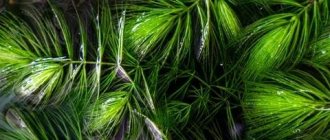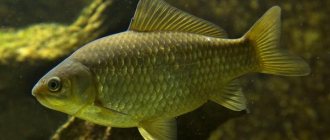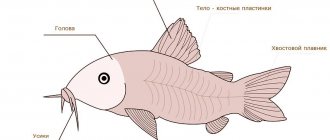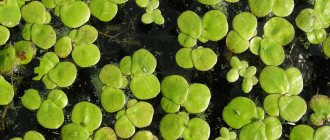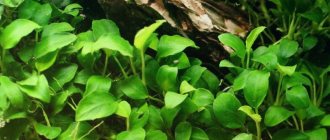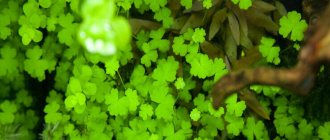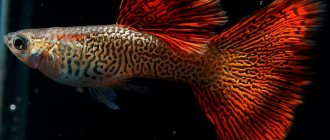Description of Riccia varieties
The aquarium plant is a liver moss and has no roots or trunk. This moss consists of plates and stems that are intertwined. The stalks are 1 mm thick, among them the fry usually hide from predatory fish. The interior of the Riccia island is filled with air bubbles; in the light they look like small pearls.
The color of Riccia depends on its condition and on how well the contents are organized. A faded green color indicates proper lighting; dark and brownish shades indicate a lack of light. When whole, Riccia looks like a carpet on the bottom or surface.
Attention! Riccia is distributed throughout all corners of the planet; there are more than 60 species of this algae. Despite the abundance of species, they may be completely different in appearance, depending on the growing conditions.
All types of riccia can be divided into two groups - regular and amano:
- Riccia amano or sinking is distinguished by elongated stems and plates, it is darker. There are about 20 species of sinking mosses; most often amano mosses are grown in aquariums. In the tropics, this variety grows in standing water. Planting Riccia amano is possible in aquariums of different sizes. Optimal conditions are fresh water and a temperature of 22-25 degrees. If the temperature drops by one degree, the algae may not survive. This fact should be a reason to buy a thermometer and a heater for your aquarium.
In good conditions, sinking riccia can grow over the entire surface of the aquarium. Such rapid growth can impair the supply of oxygen to the water, so the moss is regularly thinned. This procedure is needed 2-3 times during the summer.
Important! Riccia amano can be combined with other algae that also require good lighting.
- Riccia floating or regular looks more airy. This algae is planted during the appearance of the fry. Ciliates appear in it in large numbers; they are the main diet of young fish. Due to the fact that Riccia, floating on the surface, blocks the flow of light, it is necessary to place algae from shade-loving varieties on the bottom. Regular Riccia can also be placed at the bottom of the aquarium. You can secure it to a stone or driftwood using wire or mesh material. This must be done carefully, the plant is very delicate. In this form, Riccia looks beautiful and does not interfere with the inhabitants of the aquarium; it is low-growing and does not take up much space.
Floating Riccia successfully takes root in tropical aquariums; it easily adapts to warm water. In the summer, when the temperature rises, like other algae, the common algae needs to be thinned out. During the winter months it does not grow as intensively.
Decorating the aquarium with riccia
With the help of this plant you can realize the most daring design solutions. Riccia can not only be on the surface of the water, it can be lowered to the bottom of the aquarium. But for this you need to come up with something to keep it there. How to fix Riccia in an aquarium?
Botanical description and content features
Riccia can be found on all continents of the planet. The best conditions for its growth and development are found in temperate climatic zones of the globe.
Usually grows in stagnant bodies of water or rivers with weak currents. Riccia does not have a root system or branches protruding far outward. The organism consists of flat elements of bright green color, which grow in a dense mass on the surface of the reservoir.
The structural parts of the algae are called thallus and have the shape of small plates. They form long shoots no more than a millimeter thick, which intertwine inside, which is why Riccia from a distance can resemble a green ball.
History and morphological features
Riccia belongs to the class “Liver mosses”. These unusual plants received their name for their similarity to the corresponding animal organ. Liver mosses are ancient higher plants, the approximate age of which dates back to the Carboniferous period, but bryophyte spores are found in more ancient deposits - Silurian and Devonian (435-400 million years ago).
Obviously, liver mosses originated from algae, brown or green, that came to land. They had a very simple structure - the absence of leaves, roots and stems. Riccia has only a thallus or thallus - plates up to 1 mm in diameter, fork-shaped.
Riccia has complicated its structure compared to ancient mosses. Air chambers have formed in its thallus, allowing the plant to float on the surface of the water. Riccia propagates vegetatively. Even a small piece of thallus can become the ancestor of a whole green island. Thanks to this feature, the plant is widespread - small pieces of it are carried by the current and migrate on the legs and plumage of waterfowl.
With the onset of the cold season, the thallus becomes darker, starch grains accumulate in the cells, which makes the tender branches heavier and allows the moss to sink into the water column. The plant overwinters there. In extreme conditions, Riccia is capable of forming spores.
If the reservoir dries out or freezes to the bottom, then the spores “wait out” the unfavorable period. When the parameters necessary for life are restored, new shoots appear from the spores, giving life to entire thickets of moss.
The Riccia genus includes 173 species, but Riccia fluitans is especially popular among aquarists. It is found in the wild in bodies of water with standing or slowly flowing fresh water. This amazing aquatic organism is especially widely represented in the subtropics and tropics, but is also found in the temperate zone.
It has been used by herbalists since 1970. Riccia floating received a new round of popularity thanks to aquatic designer Takashi Amano.
Suitable conditions for Riccia
When using Riccia to decorate an aquarium, it needs certain conditions:
- it is important to reduce water hardness;
- the water in the aquarium should be slightly alkaline with a pH of 7.2;
- temperature – 22-29 degrees Celsius.
Despite its unpretentiousness, the Riccia aquarium plant suffers from temperature changes and hard water. If the water becomes colder than 21o C, the algae stops growing, it darkens and disintegrates when it dies. The same result occurs with increasing rigidity.
Attention! If necessary, you can increase the growth rate of Riccia. It is enough to cover the aquarium with glass; favorable growth conditions are created in the moist oxygen layer.
To create artificial lighting for an aquarium, it is better to use fluorescent lamps. Regular light bulbs can heat the surface of the water.
Riccia does not need feeding; it is enough to care for the aquarium according to a schedule that is built depending on the inhabitants.
Conditions of detention
The content of riccia is quite simple. It thrives in both moderately warm and tropical aquariums. For good growth, soft water with neutral or slightly alkaline acidity is desirable. If the water hardness in the aquarium exceeds 8°, then the growth of Riccia slows down. The optimal temperature is 22-26 °C. If the temperature drops below 20 °C, growth also slows down, the plant decreases in size and may even die. It is recommended to change the water weekly up to 20% of the aquarium volume .
Riccia loves bright aquarium lighting; if there is a lack of it, it breaks up into separate pieces (without forming islands), and the lower layers can even rot. In summer, the plant grows very strongly and prevents light and oxygen from entering the aquarium. Therefore, the thickets of Riccia need to be thinned out. no special feeding is needed. The plant receives enough nutrients from fresh water and fish food.
Riccia is unpretentious to water temperatures and can withstand different ranges, but it requires constant change of water in the aquarium, because very sensitive to cleanliness. In dirty, muddy water, the plant begins to deteriorate and wither. In summer, in bright sunlight, it grows quickly, filling almost the entire surface of the water, so sometimes it is recommended to thin it out, removing excess parts of the plant.
In winter, Riccia requires additional intense lighting, i.e. she lacks natural sunlight. The optimal temperature difference for it is 22-26 degrees, and at temperatures below 20 degrees it can die. It feels comfortable in soft water with a neutral reaction, but when the water hardness is more than 8 degrees, it can grow and develop much more slowly.
Riccia uses fish waste products dissolved in water, so there is no need to additionally feed the aquarium plant. If you do not change the water in the aquarium for a long time, the process of photosynthesis and nutrient processing may be disrupted . Riccia does not tolerate table salt , so if it is necessary to treat the fish, then it should be temporarily separated from the aquarium animals and this should be done in different aquariums.
Conditions
It is not difficult to keep Riccia - it adapts well to any conditions, which is what has allowed it to spread so widely. The optimal temperature for it will be the range of 22-26 ° C, but it will also survive going beyond the boundaries of this range. Some sources report that at temperatures below 20 ° C its growth stops; other authors report that Riccia can withstand prolonged exposure to water up to 15 °C. The composition of the water does not have a great influence on the condition of the plant, however, it is recommended to maintain the water hardness below 8 °, and the pH reaction in the region of 6-8. A weekly 1/5th water change is also highly advisable.
Bright lighting is the key to Riccia’s well-being. If there is a shortage of it, it may well float to the surface of the aquarium on its own in the hope of receiving more light. This state of affairs is not always desirable, because Riccia grows extremely quickly and is capable of completely covering the surface of the aquarium in a short time, dooming all its other inhabitants to stay in the dark. The most suitable light sources in this case are fluorescent lamps - incandescent lamps emit too much heat, which increases the risk of overheating the plant. The optimal distance between the lamps and Riccia is 10 cm. It is preferable to avoid prolonged exposure to direct sunlight, as this can cause the Riccia to become overgrown with blue-green algae.
Functions of Riccia in the aquarium
Despite its uncontrolled growth, keeping water moss has many advantages. Aquarists often argue about whether Riccia in the aquarium is beneficial or harmful, and completely in vain. Of the plant's shortcomings, only one can be noted - rapid growth, but with proper care no problems should arise with a lush green carpet. But there are many benefits from Riccia in an artificial reservoir:
- Saturates the aquatic environment with oxygen.
- Actively processes organic residues excreted by the inhabitants of the aquarium.
- Improves mineral metabolism.
- Serves as a shelter and place for laying eggs of certain phenotypes.
- Shades areas in the tank, creating a refuge for shade-loving species.
In addition, the Riccia plant is a tasty morsel for many residents of water bodies, especially turtles and ampularia who are not averse to snacking on the moss. And of course, what gives the plant a special value in the eyes of aquarists is the ability to beautifully decorate the aquarium space with green mosses.
Application in aquarium
Not all aquarists consider floating moss as a desirable plant. Some are frightened by its rapid growth and clogging of the reservoir. However, Riccia has several beneficial properties:
- saturation of water with oxygen;
- participation in metabolic processes of organic and mineral substances;
- is a nutritious food for some aquarium inhabitants;
- promotes the rapid development of simple organisms that are food for fry;
- creating shaded areas necessary for fry and some types of fish;
- is a good protection for eggs and fry.
In addition, using aquatic moss, you can diversify and decorate your aquarium. “Floating” species are used to create “islands,” the area of which is limited by transparent plastic or silicone rings and twines. The “sinking” one is fixed manually, creating rounded shapes. The composition is complemented with beautiful stones, driftwood, coconut shells, and ceramic cups.
Floating moss will be a wonderful decoration for an aquarium . It can be grown together with many aquarium species, the conditions of which are close to those of Riccia. Other types of moss, hybrid species of Echindorus, lileopsis, hemianthus micranthemoides, and dwarf eleocharis are well suited for keeping together with it.
It is not advisable to keep Riccia and duckweed together. They strongly shade and drown out each other.
Also, you should not try to grow moss in an aquarium where Goldfish live, since nimble fish very quickly eat this plant, preventing it from growing.
Useful properties of Riccia
Each owner has his own opinion about this algae. Some believe that this moss only clogs the aquarium, while others, on the contrary, consider this plant to be very beneficial for the water. To figure out whether this is really so, let's see what properties this algae has:
- Riccia in the aquarium actively saturates the water with oxygen;
- participates in the exchange of mineral and organic substances;
- helps fish very well that do not like intense lighting, creating shade for them;
- provides a place for fish to spawn;
- good shelter for fry;
- Simple ciliates reproduce very well in moss, and this is an excellent food for small fish;
- Riccia is loved by ampullaria and turtles;
- This plant also provides an opportunity to realize the aquarist’s various design fantasies.
Basics of aquarium keeping Riccia
The most suitable temperature in the aquatic environment for this plant is +22…+30 °C. If it falls below the designated minimum, then growth will first slow down, and then the organism will die.
Riccia prefers water with low hardness. If this indicator exceeds the 8 dH level, this will negatively affect the development and immunity of the plant. Acidity should be maintained at around 5-6 pH.
When kept in a home aquarium, the liquid should be regularly updated, adding up to 30% of the total volume.
For growth to be balanced and harmonious, the body must receive intense light. In this case, direct sunlight should be avoided - in bright rooms it is better to place the aquarium in a shaded area. Lamps with an incandescent spiral are also not suitable - the heat emanating from them can negatively affect the temperature regime of the plant. The soil does not require additives for the growth of Riccia - it only needs a basic set of minerals, which are contained in fish feed mixtures.
Thanks to the complex structure that the thallus forms, small fish can use Riccia as a shelter, and labyrinth fish will find a permanent shelter inside and build nests there. Also, a dense mass is often used by owners of home aquariums to create shade under water and retain oxygen coming from outside. Such an environment promotes the development of ciliates. These organisms are eaten by young animals, which are formed from eggs.
To limit the growth of Riccia, it can be placed inside a stocking or net attached to the aquarium. Some experts simply tie an island of moss to a stone or other decorative elements.
The plant does not tolerate shaking and frequent movements.
Riccia goes well with mosses, echinodorus, lileopsis, hemianthus, and dwarf eleocharis. You should not plant it in the same tank with duckweed; the species have similar characteristics and they will interfere with each other.
Content
Monosolenium and Riccia require:
Large and herbivorous fish will severely damage the bryophyte. Place liver moss in a tank with small omnivorous and carnivorous fish:
How to plant Riccia
With the help of liver moss you can create original aquarium landscapes. To do this, you can use the simple techniques described below.
On a stone, coconut or driftwood
How is riccia placed on a stone?
Using the same principle, you can decorate aquarium driftwood, stones, or create original decorations using coconut. Before you begin, you should treat the object to which the plant will be attached with a saline solution.
The moss must be placed on the object and secured with a net. As the plant grows, it will hide the mesh and create a bright green coating in the aquarium interior.
floating island
This design can be created by fastening already grown tufts of moss using thread or fishing line.
Vertical mat
To create such a decoration, you need to select a strong fishing line, lower one end of it into the aquarium and secure it with a weight. Bring the other end to the surface of the aquarium and also secure it. Bunches of riccia must be tied to the fishing line. As the moss grows, it will gradually hide the support and form a beautiful decor.
Aquarium volume and water parameters
Riccia in the aquarium.
An aquarium with a volume of at least 10 liters is suitable for Riccia. Moss is unpretentious to the water in which it is found. But the most comfortable temperature for it is +22…+26 ºС; lower temperatures can negatively affect its growth.
It is also recommended to use water with the following parameters: soft water with an indicator of 5-8 dH and an acidity level of no more than 5 pH.
You should avoid contaminating the water and change it every few weeks; the recommended water change rate is 20% of the aquarium volume. If these standards are not followed, a white coating may form on the riccia, which will prevent the release of oxygen.
Plant nutrition
Riccia in an aquarium does not require additional mineral feeding, unlike other plants. She receives waste products from fish, which form organic soil for feeding. If the water is too saturated with impurities of organic matter and lime, plaque will form on the moss stems, which will interfere with the process of photosynthesis, preventing light from penetrating. If the fish need quarantine, or there is a need to add salt or medicine, then it is better to temporarily move the fish to another aquarium, then nothing will happen to the Riccia. After all, it does not tolerate the presence of salts in water at all.
Reproduction
To propagate the plant, several shoots should be carefully separated from the total mass. Located in a new place, for example, in another container, they begin to grow intensively and, under favorable conditions, can develop into an island that will exceed the size of the first one, and in exceptional cases, occupy the entire available surface of the water.
Additionally, excess algae should be removed by hand regularly. This is especially true for cases where the aquarium is located in a well-lit room with proper temperature conditions.
The plant can become so dense that it limits the oxygen supply to other inhabitants. This has a detrimental effect on some fish (for example, labyrinth fish - they need to regularly come to the surface to grab air).
Care
Caring for water moss is extremely simple: the plant, due to its rapid development, requires constant pruning. To ensure that the tank looks well-groomed and oxygen and light penetrate deep into the water column, the lush green carpet is trimmed once every two weeks, removing excess bushes.
Speaking about care, it is important to note a feature: water moss does not like table salt, so it is not advisable to use this product to treat fish.
Maintenance and care in the aquarium
Riccia is undemanding, but without proper maintenance it will die.
Lighting
Sunlight alone will not be enough. Additionally (especially in winter) it is necessary to provide incandescent and fluorescent lamps. It will be good if the aquarium is placed on the south or west side. Due to lack of light, the algae fades and disintegrates.
Using only incandescent lamps, you will have to monitor the temperature. If the plant overheats, the top layer will dry out and die. Lamps should be installed at a distance of 10-15 cm from the surface of the container.
Water
Rhineland Riccia needs an aquarium of up to 50 liters, and for other species it can be from 10 liters. Without weekly changes (by 15-20%), the water becomes cloudy, the thallus becomes dirty, and photosynthesis is disrupted. With a strong current, the algae breaks up into small pieces. Water indicators:
- for relatively rapid growth +22-26° C, at temperatures up to +18° C the algae slows down;
- hardness up to 14° dH;
- acidity from 5.5-8 pH.
Increased salt levels will kill the algae.
Feeding
If there are fish, shrimp, snails or other inhabitants in the aquarium, then there is no need to additionally feed the algae. The algae will receive all its benefits from the remains of the inhabitants’ food.
Adding carbon dioxide
Algae floating on the surface do not require additional additives. For rooted species, the CO2 content in the aquarium should be 15-30 mg/l. A high concentration of carbon dioxide and good lighting will create bubbles, which makes the algae even more attractive. But this is only permissible for a planted aquarium. If Riccia is kept with aquarium fish, the presence of carbon dioxide (more than 20 mg/l) has a bad effect on them.
How to care
Rapid growth upsets the ecological balance: little oxygen and light enter the aquarium. It is necessary to carry out the following procedures: remove all excess and rinse in clean water.
What everyone should know about Riccia in the aquarium
Riccia can be found in almost every corner of the Earth. This plant has a completely different structure than most aquarium plants. Riccia floating is a beautiful plant that can be used to decorate the bottom of an aquarium, artificial shading or feeding fish.
The plant grows quickly in comfortable conditions and is capable of forming a carpet 2-3 cm thick in a short time. Riccia is useful for fish that love the dark, since, floating above the water, it does not allow daylight to penetrate into the aquarium.
